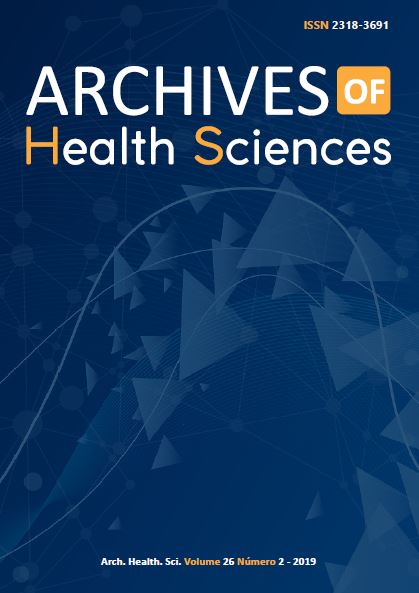Bacterial outbreaks in a Neonatal Intensive Care Unit: a five year history
DOI:
https://doi.org/10.17696/2318-3691.26.2.2019.1431Keywords:
Outbreak; Nosocomial Infection; NeonatesAbstract
Introduction: Neonatal Intensive Care Unit (NICU) hospitalization is usually prolonged, and neonates are submitted to several risk factors, allowing the occurrence of outbreaks from time to time despite precautions. Objective: To investigate the occurrence of bacterial outbreaks in an NICU of a university hospital in the interior of Minas Gerais from January 2013 to December 2017. Methods: Data were collected from the records of outbreaks occurring in NICUs available in the documents of the Hospital Infection Control Service, including the National Healthcare Safety Network - NHSN records, memos, test results, and electronic records of outbreak descriptions. Results: Four outbreaks were observed over a fiveyear study period. The first outbreak occurred in 2013, due to infection of the bloodstream by the species Pantoea agglomerans and involved six neonates. The second occurred between November 2014 and March 2015, where six neonates were involved and there was no predominant site, Acinetobacter B being the microorganism isolated. Similarly, the third outbreak occurred in 2015 by the same agent, comprising 10 neonates. The last outbreak occurred in 2016 by Pseudomonas aeruginosa, being a predominantly colonization outbreak, where 13 neonates were affected. There were no outbreaks in 2017. Conclusion: Four epidemiological outbreaks were identified, all of them by Gram-negative bacteria. The most affected neonates were preterm and low birth-weight infants. Microorganisms resistant to carbapenems have been identified which, although few, proved to be a problem at the study site.
References
Oliveira Paula A, Marques Salge AK, Prado Palos MA. Infecciones relacionadas con la asistencia a la salud en unidades de terapia intensiva neonatal: una revisión integradora. Enferm Glob. 2017;16 (45):508-22. http://dx.doi.org/10.6018/eglobal.16.1.238041.
Romanelli RMC, Anchieta LM, Mourão MVA, Campos FA, Loyola FC, Mourão PHO, et al. Risk factors and lethality of laboratory-confirmed bloodstream infection caused by non-skin contaminant pathogens in neonates. J Pediatr (Rio J.). 2013;89(2):189-96. http://dx.doi.org/10.1016/j.jped.2013.03.002.
Nercelles P, Veneonatoal S, Brenner P, Rivero P. Riesgo de bacteriemia asociada a dispositivos intravasculares estratificados por peso de nacimiento en recién nacidos de un hospital público de alta complejidad: seguimiento de siete años. Rev Chilena Infectol. 2015;32(3):278-82. http://dx.doi.org/10.4067/S0716-10182015000400004.
Su JZ, Yang YL, Rong R, Wu BQ. Genotype and homology analysis of pathogenic and colonization strains of Candida albicans from hospitalized neonates. Pediatr Neonatol. 2018;59(5):488-93. DOI: https://doi.org/10.1016/j.pedneo.2017.12.006.
Shirani K, Mostafavizadeh K, Ataei B, Akhani K. Colonization with hospital flora and its associated risk factors in neonates hospitalized in neonatal ward of a teaching center in Isfahan, Iran. J Res Med Sci. 2018;23:5. doi: http://dx.doi.org/10.4103/jrms.JRMS_860_16.
Erdmann AL, Lentz RA. Conhecimentos e práticas de cuidados mais livres de riscos de infecções hospitalares e o processo de aprendizagem contínua no trabalho em saúde. Texto Contexto Enferm. 2004;13(Esp):34-49. http://dx.doi.org/10.1590/S0104-07072004000500004.
Center of Disease Control and Prevention. National Healthcare Safety Network – NHSN [homepage na Internet]. Atlanta: CDC; 2015 [acesso em 2018 Nov 2]. About NHSN; [aproximadamente 1 tela]. Disponível em: http://www.cdc.gov/nhsn/about-nhsn/index.html. Atlanta; 2015.
Siqueira CCM, Guimarães AC, Mata TED, Santos RP, Raymundo NLS, Dias CF, et al. Prevalence and antimicrobial susceptibility profile of microorganisms in a university hospital from Vitória (ES), Brazil. J Bras Patol Med Lab. 2018;54(2):76-82. http://dx.doi.org/10.5935/1676-2444.20180014.
Organização Pan-Americana da Saúde. Módulo de princípios de epidemiologia para o controle de enfermidades (MOPECE). Módulo 5: Investigação epidemiológica de campo: aplicação ao estudo de surtos. Brasília (DF); 2010.
Rodel J, Mellmann A, Stein C, Alexi M, Kipp F, Edel B, et al. Use of MALDI-TOF mass spectrometry to detect nosocomial outbreaks of Serratia marcescens and Citrobacter freundii. Eur J Clin Microbiol Infect Dis. 2019;38(3):581-91. doi: http://dx.doi.org/10.1007/s10096-018-03462-2.
Patel SJ, Green N, Clock SA, Paul DA, Perlman JM, Zaoutis T, et al. Gram-Negative bacilli in infants hospitalized in the neonatal intensive care unit. J Pediatric Infect Dis Soc. 2017;6(3):227-30. doi: http://dx.doi.org/10.1093/jpids/piw032.
Segado-Arenas A, Alonso-Ojembarrena A, Lopez SL, Garcia-Tapia A. Pantoea agglomerans: ¿um nuevo patógeno en la unidad de cuidados intensivos neonatales? Arch Argent Pediatr. 2012;110(4):77-9. DOI: http://dx.doi.org/10.1590/S0325-00752012000400017.
Van Rostenberghe H, Noraida R, Wan Pauzi WI, Habsah H, Zeehaida M, Rosliza AR, et al. The clinical picture of neonatal infection with Pantoea Species. Jpn J Infect Dis. 2006;59(2):120-1.
Wang TH, Leu YS, Wang NY, Liu CP, Yan TR. Prevalence of different carbapenemase genes among carbapenem-resistant Acinetobacter baumannii blood isolates in Taiwan. Antimicrob Resist Infect Control. 2018;7(123):1-8. doi: http://dx.doi.org/10.1186/s13756-018-0410-5.
Costa AR, Monteiro R, Azeredo J. Genomic analysis of Acinetobacter baumannii prophages reveals remarkable diversity and suggests profound impact on bacterial virulence and fitness. Sci Rep. 2018;8(1):1-11. DOI: http://dx.doi.org/10.1038/s41598-018-33800-5.
Sultan AM, Seliem WA. Identifying risk factors for healthcare-associated infections caused by Carbapenem-Resistant Acinetobacter baumannii in a Neonatal Intensive Care Unit.. Sultan Qaboos Univ Med J. 2018;18(1):e75-80. doi: http://dx.doi.org/10.18295/squmj.2018.18.01.012.
Zhang Y, Faucher F, Zhang W, Wang S, Neville N, Poole K, et al. Structure-guided disruption of the pseudopilus tip complex inhibits the Type II secretion in Pseudomonas aeruginosa. PLOS Pathog. 2018;14(10):1-27. doi: http://dx.doi.org/10.1371/journal.ppat.1007343.
Gholami M, Chirani AS, Falak R, Moshiri M, Razavi S, Irajian G. Induction of specific humoral immune response in mice against a Pseudomonas aeruginosa Chimeric PilQ/PilA Protein. Rep Biochem Mol Biol. 2018;7(1):38-44.
Dias C, Gonçalves M, João A. Epidemiological study of Hospital-Acquired bacterial conjunctivitis in a level iii neonatal unit. Scientific World J . 2013;1-5. doi: http://dx.doi.org/10.1155/2013/163582.
Downloads
Published
Issue
Section
License

This work is licensed under a Creative Commons Attribution-NonCommercial-NoDerivatives 4.0 International License.










